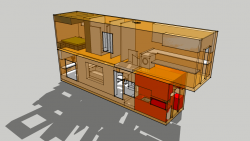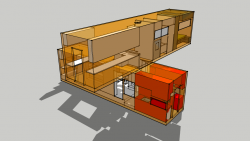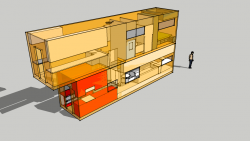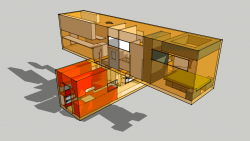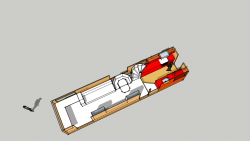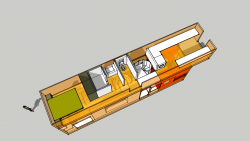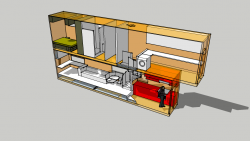Update
It seems to me a trailer park filled with these two-story container houses would be amazing... perhaps even the ideal living environment. The stackability of shipping containers and the relatively small overall size of these homes means one could build a densely populated neighborhood, with interesting structures arranged around shared open spaces.
Original Post
Hiro and I are making progress on the dream home! In addition to the Shoebox House described earlier, we’re exploring another design concept called the Two Box House. Working with Ron Golan of (RGON Architecture), we’ve now have a 3D model of the rough schematic design. Here are the first renderings! (Note the shadows are a little wacky because the walls are made transparent.)
Parallel configuration
Perpendicular configuration
The Two Box House is a 575 sq/ft modular home assembled from two, 40′ shipping containers, one trimmed to 35′. The upper container can be stacked either parallel or perpendicular to the first floor. The parallel configuration minimizes the home’s footprint, allowing the home to be placed on small and oddly-shaped lots. When space is available, the perpendicular configuration makes for a more dynamic structure and creates two usable roof patios as well as a covered entry at ground level. The Two Box House is designed to meet or exceed standard LA County building code, meaning it can be placed on regular, residential lots. The modular design simplifies the foundation requirements and makes it easy to move the whole home. The Two Box House has the potential to be very eco-friendly, using recycled shipping containers for the structure.
Parallel configuration, opposite side
Perpendicular configuration, opposite side
As shown below, the first floor consists of an office space, living room, and dining area, all situated on a raised floor. The main entry is opposite the stairs. The kitchen (red cabinets) are at one end with an additional entry.
First floor
The second floor consists of the bedroom, a shower and lavatory, the toilet, and a workspace we’re calling the project room.
Second floor
Cross-section view, both floors
The stairs present many of the home’s most challenging design issues. The stairs must meet code within the home’s limited interior width (7’8″) and the second-floor landing must accommodate the home’s parallel and perpendicular configurations. Ron was able to painstakingly design a spiral staircase to meet the requirements. Situating the stairs near the kitchen allowed us to keep the office and living spaces contiguous and a raised floor reduced the total number of steps, limiting the stairs’ reach out into the room.
View from office into kitchen
Hiro and I are very excited about this design! It feels like the interior will be cozy but not stifling, the construction will be relatively straightforward, and the whole project is more environmentally friendly than the Shoebox House. I now need to explore the engineering and legal challenges more closely. Specifically, I need to figure out how the insulation on the outside of the containers would still allow a crane to hoist the boxes, and I need to start searching for oddly-sized (and thus hopefully more affordable) residential lots in LA County. Fun stuff!
